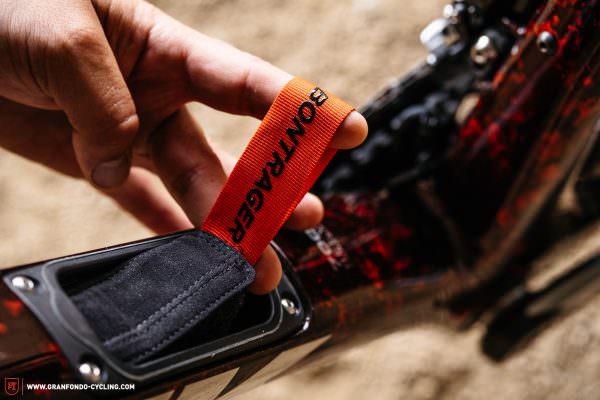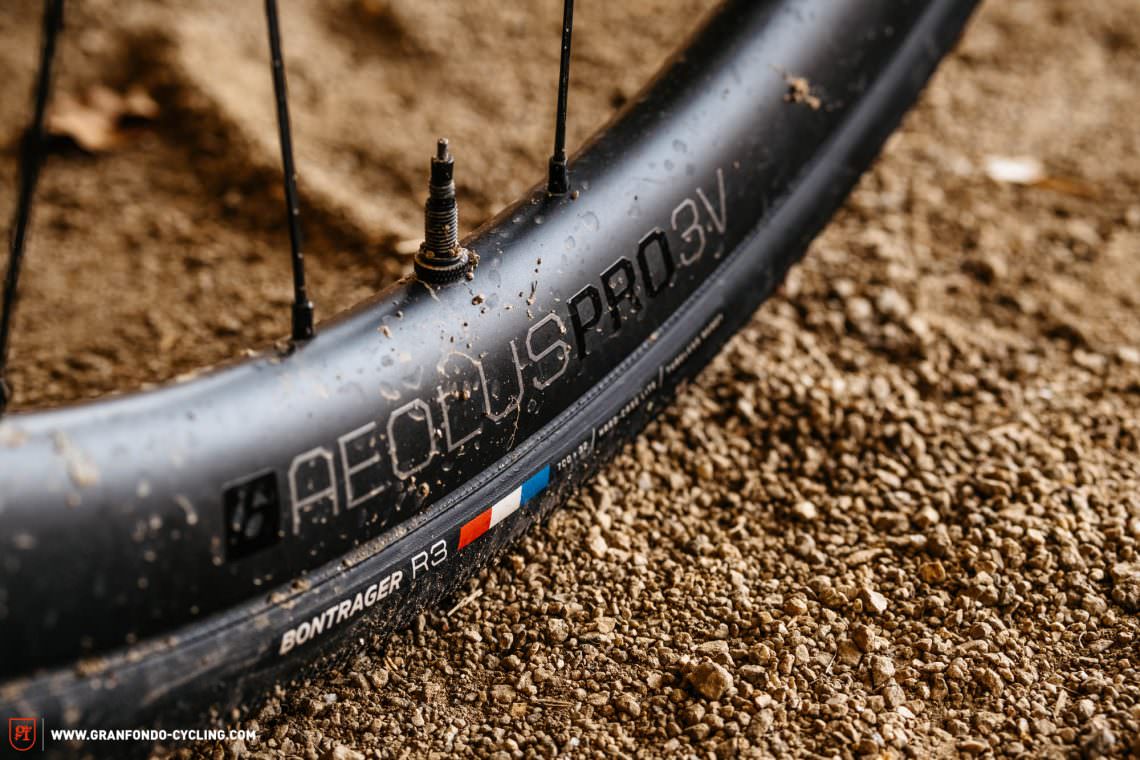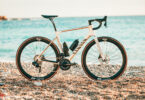The Trek Domane SLR 9 eTap wants to combine endurance race performance, high levels of comfort and all-round riding characteristics. Does the platform, which has already had wins at the Roubaix and Flanders races, have a chance at success in our gravel group test?
Click here for an overview of the best gravel bike 2020 group test.

Developed to dominate the Spring classics, the Trek Domane SLR 9 eTap has a range of unique features. The updated IsoSpeed system, adopted from the current Trek Madone, is designed to offer the highest level of comfort. It consists of two components. At the rear, the seat tube is decoupled from the top tube, allowing it to swing freely with adjustable compliance. An updated integrated damper is designed to reduce the undamped, springy feeling of previous versions. Up front, Trek uses the same principle by decoupling the top half of the steerer tube from the head tube to provide more compliance. The design prevents lateral movement, meaning the handling of the bike shouldn’t be affected. Additional comfort is provided by the vibration damping IsoCore carbon bar which features an elastomer fill. Integrated mounts for light, mudguards and the internally routed cables all contribute to the clean look. A compartment in the down tube eschews the need for a saddlebag, offering space for a tube, multi-tool, tyre levers and CO2 cartridge. The frameset clears up to 700 x 38C tires and is constructed from Trek’s 700 OCLV carbon – Trek’s high-end carbon construction. Our test bike came with a complete 2×12 SRAM RED eTap AXS groupset and Bontrager Aeolus Pro 3V wheelset, weighed 8.08 kg in size 56 and costs € 11,299.

The Trek Domane SLR 9 eTap in detail
Drivetrain SRAM RED eTap AXS
Gearing 48/35 t and 10-28 t, 2×12
Brakes SRAM RED HRD, 160/160 mm
Handlebar Bontrager IsoCore VR-CF, 420 mm
Stem Bontrager XXX, 100 mm
Seatpost Bontrager Integrated, 20 mm offset
Wheels Bontrager Aeolus Pro 3V
Tires Bontrager R3 TR, 700 x 32C

The cable routing into the frame at the cockpit doesn’t quite fit the rest of the tidy and sleek concept.

The compliance of the rear IsoSpeed system can be adjusted with a slider.

The compartment in the down tube is in a clever position and can be accessed easily with the lever under the bottle cage, as well as having enough space for all your essentials.

The freewheel of the Aeolus Pro 3V wheels engages quickly and ensures direct power transfer. In addition, Bontrager offers its Carbon Care Program with free repairs or replacements in the first two years.
| Size | 44 | 47 | 50 | 52 | 54 | 56 | 58 | 60 | 62 |
|---|---|---|---|---|---|---|---|---|---|
| Seat tube | 390 mm | 420 mm | 450 mm | 475 mm | 500 mm | 525 mm | 548 mm | 567 mm | 586 mm |
| Top tube | 501 mm | 509 mm | 519 mm | 530 mm | 542 mm | 554 mm | 567 mm | 579 mm | 593 mm |
| Head tube | 95 mm | 110 mm | 130 mm | 145 mm | 160 mm | 175 mm | 195 mm | 220 mm | 245 mm |
| Head angle | 70.3° | 71.0° | 71.1° | 71.3° | 71.3° | 71.9° | 72.0° | 72.1° | 72.1° |
| Seat angle | 74.6° | 74.6° | 74.6° | 74.2° | 73.7° | 73.3° | 73.0° | 72.8° | 72.5° |
| Chainstays | 420 mm | 420 mm | 420 mm | 420 mm | 420 mm | 420 mm | 425 mm | 425 mm | 425 mm |
| BB Drop | 80 mm | 80 mm | 80 mm | 80 mm | 80 mm | 78 mm | 78 mm | 75 mm | 75 mm |
| Wheelbase | 983 mm | 986 mm | 996 mm | 1,003 mm | 1,010 mm | 1,008 mm | 1,022 mm | 1,032 mm | 1,042 mm |
| Reach | 360 mm | 364 mm | 368 mm | 371 mm | 374 mm | 377 mm | 380 mm | 383 mm | 386 mm |
| Stack | 510 mm | 527 mm | 546 mm | 561 mm | 575 mm | 591 mm | 611 mm | 632 mm | 656 mm |
The Trek Domane SLR 9 eTap in review
In comparison to its test competitors, the Trek is a decidedly quick accelerator. Its excellent efficiency makes climbing easy and riding at high speeds a true delight. It’s not at all susceptible to crosswinds, offers a stable ride as well as very capable and intuitive handling. On the road, the sporty Standert has a slight advantage in terms of speed, but the scales tip in the Trek’s favour on gravel. The relatively compact position, the excellent stability and its high comfort make it the perfect companion on forest tracks. However, if you’re looking for an aggressive position, more precision and more agile handling, you might be better served by the Standert.

Fill the storage compartment with Haribos and head for the Strade Bianche


The Project One finish is called New Molten Marble and will melt the roads you ride
Loose ground and technical terrain can be ridden, but are not the Trek’s forte as it quickly reaches its limits here. The IsoSpeed system convinced us throughout the test period with its high level of comfort. The adjustable and well-damped compliance is a big improvement over previous versions of the concept. The down tube storage compartment can hold all the spares you need, while the low position helps maintain the bike’s centre of gravity. It’s just the inlet on the top tube for the internally routed cables that doesn’t quite match the otherwise sleek design.

Conclusion
If you’re on the lookout for an endurance bike for training, long rides, occasional gravel excursions and your next Gran Fondo, you don’t need to look any further. With the Trek Domane SLR 9 eTap, the American brand has introduced an innovative and coherent concept with high levels of comfort, innovative features and lots of stability. Quick direction changes that require precise line choice or riding on technical terrain are not the Trek’s strengths, which neither is nor wants to be a dedicated gravel bike.
Tops
- good stability
- high comfort without a negative impact on efficiency
- confidence-inspiring at speed
- innovative
Flops
- cable routing around the cockpit
- limited in technical terrain
Riding Characteristics
4Agility
- cumbersome
- playful
Stability
- nervous
- confident
Handling
- demanding
- balanced
Fun factor
- boring
- lively
Value for money
- terrible
- very good
For more info: trekbikes.com
Click here for an overview of the best gravel bike 2020 group test.
All bikes in test: Argon 18 Dark Matter | Cannondale Topstone Carbon Ultegra RX | Canyon Grail AL 7.0 | Cervélo Áspero | Giant Revolt Advanced Pro Force | Kona Libre AL | Liteville 4-ONE MK1 | OPEN WI.DE. | Pivot Vault Team Force | ROSE BACKROAD GRX RX810 Di2 | Santa Cruz Stigmata CC | Specialized Turbo Creo SL Expert EVO | Standert Pfadfinder | Trek Domane SLR 9 eTap
No, it’s not about perfect race tracks, it’s about efficiency. Fast, fleet-footed and efficient – those who want to speed along high-speed passages need a defined and spritely bike that accelerates with ease and efficiency. Nevertheless, reliable components are important too. We interpret “Smooth tarmac” bikes as follows: Hard efforts at high speeds with a maximum efficient bike on a consistently well-paved road. Effort-joy ratio: 80:30 (not everything has to be 100%!)↩
… also known as bike riding. Broken-up roads in the hinterland, deadlocked gravel roads, loose surfaces – sometimes muddy, sometimes bone-dry. For this, it takes bikes with super all-round, handling and wearing qualities uphill and downhill. Effort-joy ratio: 50:50↩
If you want to use your bike almost every day, you usually do not need an extremely tuned racing machine. Solid components, which are able to cope with the rigours of continuous usage in any kind of weather, are part of the basic equipment. At the same time, the bike should have practicable details: integrated fenders/assembly options, luggage racks/attachment points and a light system or at least the option of installing bike lights. The position on the bike should be rather relaxed, the overall comfort high, so that the Afterwork Ride becomes a cure and not a curse. Effort-joy ratio: 30:70↩
You can find more info about our rating system in this article: Click here! ↩
Did you enjoy this article? If so, we would be stoked if you decide to support us with a monthly contribution. By becoming a supporter of GRAN FONDO, you will help secure a sustainable future for high-quality cycling journalism. Click here to learn more.
Words: Photos: GRAN FONDO-Team







